In search of the invisible
Engela Duvenage
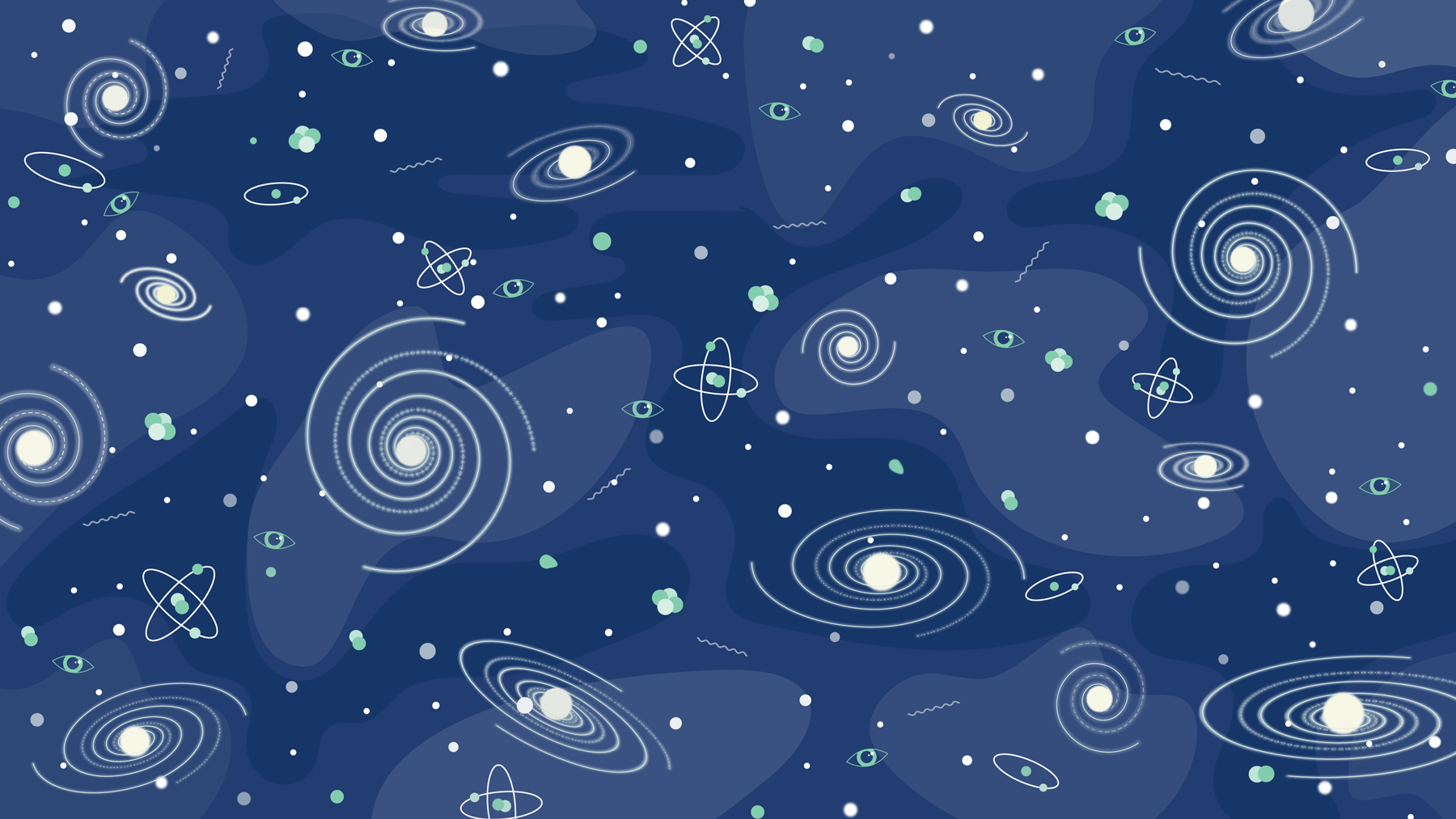
Illustration by Ronel van Heerden
In a single minute, a video stored on astrophysicist Prof Yin-Zhe Ma’s phone captures how, over the course of billions of years, our universe evolved out of darkness into potentially millions of galaxies, stars, and pulsars.
“It’s absolutely beautiful,” he sighs with pleasure once the 60 seconds of digitally simulated evolution end.
As lead of the Astronomy and Astrophysics Research Group in the Department of Physics at Stellenbosch University (SU), Ma knows better than most that the on-screen portrayal captures only around 4.8% of the full universe — that is to say, only the visible part.
Gravity originating from this visible matter is simply not enough to have led to the formation of our galaxy or stars, he says. “We therefore know that there must be ‘more’.”
Other physicists agree, but no one has yet seen this ‘more’ or been able to pin it down. Finding it is considered one of the holy grails of science.
“What you learn in physics is generally restricted to the 4.8% of visible matter. Another 25% is dark matter, of which we know the gravitational nature. The majority of the universe, however — dark energy — remains unknown. We don’t know its nature. It could function completely differently to the way we know. It’s even more mysterious than dark matter. That 70% is the biggest thing in the universe that we can work on,” Ma muses.
Researchers and students of the Astronomy and Astrophysics Group in the Department of Physics at SU focus on:
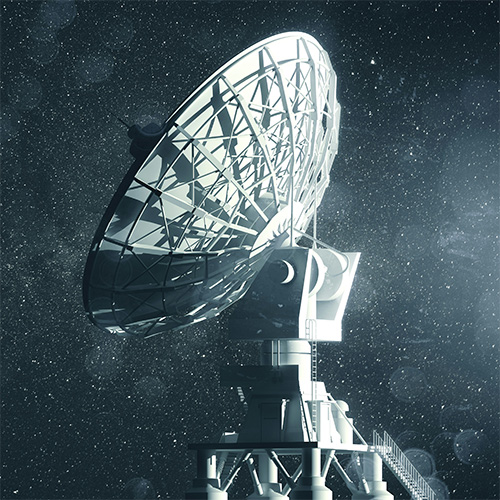
Radio astronomy:
The Epoch of Reionisation, dark matter searches, pulsar timing arrays, and 21-cm intensity mapping.
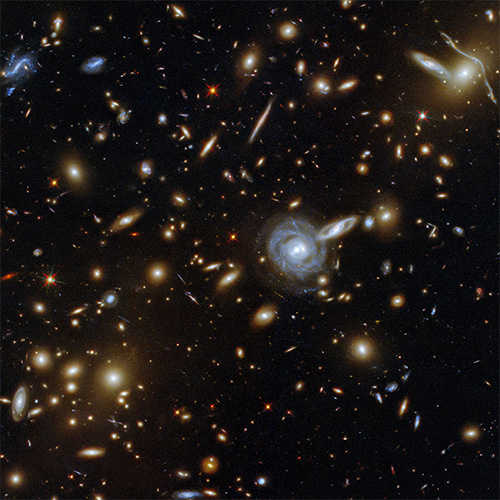
Extragalactic astronomy:
The galaxy peculiar velocity field, thermal-kinetic Sunyaev-Zel’dovich effect, dynamics of the Local Group (the galaxy group to which the Milky Way belongs), and near-field cosmology.
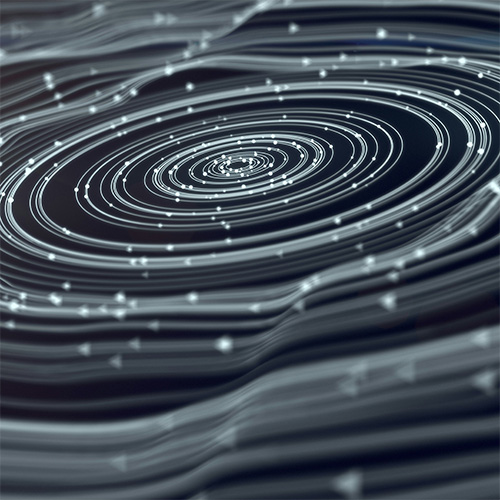
Theoretical cosmology:
The cosmic microwave background radiation, observational tests of the cosmic inflation theory, and gravity theories.
The quest to find dark energy
Since his student years in China and the United Kingdom, it has been Ma’s mission to connect fundamental physics with astronomical observations in order to understand the basic laws of the universe, as well as its expansion and the birth of the first galaxies (the so-called Cosmic Dawn and Epoch of Reionisation, respectively). Naturally, he also hopes to unravel the very nature of dark matter and dark energy, and to find ways to detect it and better understand its role in the expansion of the universe.
The term ‘dark energy’ was coined in 1998. In 2012, the journal Science claimed it was likely one of three things: “It could simply be a property of empty space itself. Einstein’s theory of gravity, known as general relativity, allows for just such a ‘cosmological constant’ that would be a property of the vacuum and would stretch space. Or, in a radically different alternative, dark energy could be a new type of force field that occupies space, much as air fills a balloon. That second alternative is known as ‘quintessence’. Finally, dark energy could be an illusion, a sign that scientists’ understanding of gravity as encapsulated in general relativity isn’t quite right.”
Ma’s quest is clearly not an easy one. In the words of Nobel Prize-winning astrophysicist James Peebles: “You don’t know where to look, so you have to work hard and look everywhere.”
“We may or may not find dark energy. It’s very challenging,” Ma admits. “Even if we don’t, we hope to find unique constraints that exclude some regions, so that we may know it’s not there and that we should search elsewhere. In other words, we hope to exclude some windows of opportunity — that would also contribute to science.”
What is dark matter and energy? | Kurzgesagt
Signs of dark matter
To this end, PhD student Phillip Badenhorst is analysing data on two dwarf spheroidal galaxies, Reticulum II and Tucana II, captured in 2022 by the MeerKAT radio astronomy array in the Karoo in South Africa’s Northern Cape. The two galaxies lie some 98 000 and 82 000 light years, respectively, from Earth.
“While relatively smaller than our Milky Way, Reticulum II and Tucana II still contain millions of stars. They are also reasonably close, considering the vast scale we are working on,” Badenhorst explains.
After studying physics at the University of Pretoria, Badenhorst worked as a software developer in the gaming industry. He quit his job, however, when he read about the opportunities offered through SU’s Astrophysics Research Group. He is now examining data on the two aforementioned dwarf spheroidal galaxies in the hope of discovering signs of axions, hypothetical particles that many believe can play an important role in the search for dark matter in the cosmos.
“Axion-like particles constitute an extremely light and elusive type of dark matter,” explains Dr Michael Sarkis, a postdoctoral researcher in the group.
“This type of dark matter will only be revealed through the most precise observations of astrophysical objects — something which the MeerKAT telescope (and eventually the Square Kilometre Array, or SKA) is well suited for,” he says.
As part of his PhD in physics at the University of the Witwatersrand, Sarkis developed a technique for modelling radio signals expected to be ‘seen’ emanating from dark matter. That proved to be a job easier said than done.
“My collaborators and I used these models to search for dark matter in images of galaxy clusters taken with MeerKAT. We didn’t find any indication of these emissions, but drew some conclusions about what the nature of dark matter could be,” he says.
Sarkis’ postdoctoral research is following along similar lines. This time round, he is using observations of the Milky Way provided by the MeerKAT-related Thousand Pulsar Array as part of the MeerTime project. These observations are of a group of more than a hundred highly compact, magnetised stars called ‘pulsars’.
“Although we cannot see dark matter or dark energy directly, we indirectly study them by using visible matter. This constrains possible models of invisible matter,” Ma explains.
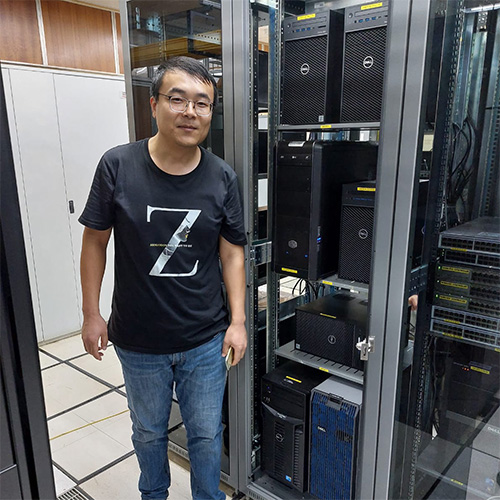
Postdoctoral researcher Dr Guo-Jian Wang with the research group’s 10-terabyte server (the blue device that looks much like a hard drive), on which huge chunks of data received from radio telescopes are being stored for further analysis. | Photo by Tinus Botha
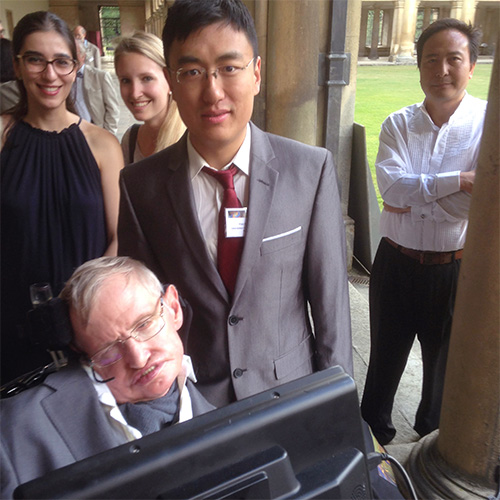
Prof Ma, pictured here with famed physicist Stephen Hawking at his last birthday conference, titled 'Gravity and Black Holes’', in July 2017. | Photo supplied
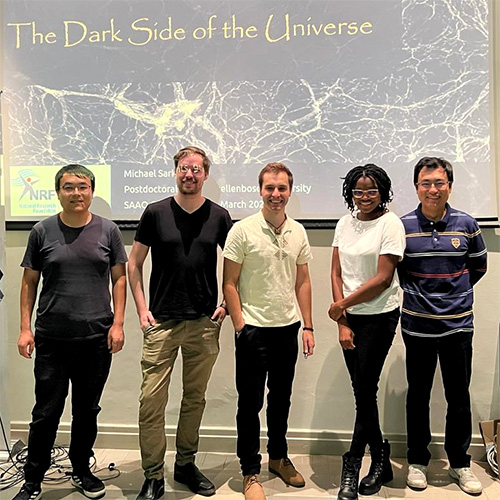
Members of the SU Astronomy and Astrophysics Research Group at an open night of the South African Astronomical Observatory in Cape Town, in March 2024. (From the left, postdoctoral researcher Dr Guo-Jian Wang, PhD student Phillip Badenhorst, postdoctoral researcher Dr Michael Sarkis, MSc student Victoria Nakafingo, and research group leader Prof Yin-Zhe Ma.) Other members not pictured are PhD student Clinton Stevens and postdoctoral researcher Dr Sheean Jolicouer. Dr Sarkis presented a talk titled ‘The Dark Side of the Universe’. | Photo by Abigail Thambiran.
Carving out a research niche
In 2023, his endeavour to set up the Astronomy and Astrophysics Research Group already broke new ground for SU. It is the first entity at the institution to focus specifically on the science rather than the engineering behind MeerKAT. SU engineers and alumni have, since the early 2000s, been involved in the design of the MeerKAT dishes, and in ensuring that electricity supply to the site, 90 km from Carnarvon in the Northern Cape, does not interfere with radio signals being collected from outer space.
Ma believes their group’s practical use of terabytes worth of data gathered by MeerKAT and other radio astronomy telescopes will provide noteworthy links between existing research nodes in engineering and physics at SU, as well as between the University’s recently established research programmes in theoretic and quantum physics and SU’s School of Data Science and Computational Thinking.
His group also has access to data from some of the other best telescopes in the world, such as those of the Hydrogen Epoch of Reionisation Array (HERA) in South Africa, the Vera C. Rubin Observatory being built in Chile, China’s Five-Hundred-Metre Aperture Spherical Radio Telescope (FAST), the fourth-generation ground-based cosmic microwave background (CMB-S4) experiment, the Atacama Cosmology Telescope, the South Pole Telescope (SPT), the European Southern Observatory (ESO) Kilo-Degree Survey (KiDS), and the Dark Energy Spectroscopic Instrument (DESI) in the USA.
Ma says they deliberately focus their research on the Epoch of Reionisation, extragalactic astronomy, the early universe, and ways to indirectly detect dark matter, neutron stars and black holes. He wants to carve out a specific niche for SU’s researchers rather than duplicate sterling work already done, over many years, by established research groups at, for instance, the nearby University of Cape Town and the University of the Western Cape.
Since 2023, Ma’s group has grown to 10 members. He says many young people are attracted to studies in astronomy and astrophysics as these are currently probably the best-funded disciplines in South African science, given the strong governmental support to related large-infrastructure projects such as MeerKAT over the past two decades.
Another new endeavour is the Joint Astronomy Chair between SU and the University of Groningen in the Netherlands, the latter ranking among the world’s 70 best universities in the fields of astrophysics and astronomy. Set up in June 2024, the Chair offers 10 co-supervised PhD students the opportunity to study at both universities and to receive funding while abroad. The process of recruiting students to conduct cutting-edge astrophysics research on the Epoch of Reionisation, structure formation, and dark matter is currently underway.
Ma describes the “ideal astrophysics students” as having a strong maths and physics background, as well as knowledge of programming, data handling, and statistical analysis. More importantly, however, they must be able to work independently, be open-minded, and be able to collect information from a variety of data sources and connect it to aspects of theory.
“Being open-minded means that they should be comfortable enough to actively engage in different academic activities, go to seminars and conferences, and listen to talks by experts that fall outside of their boundary box — and then, very importantly, absorb the useful information.
“Science is always interconnected,” reiterates Ma, whose mission it is to find the yet unfound.
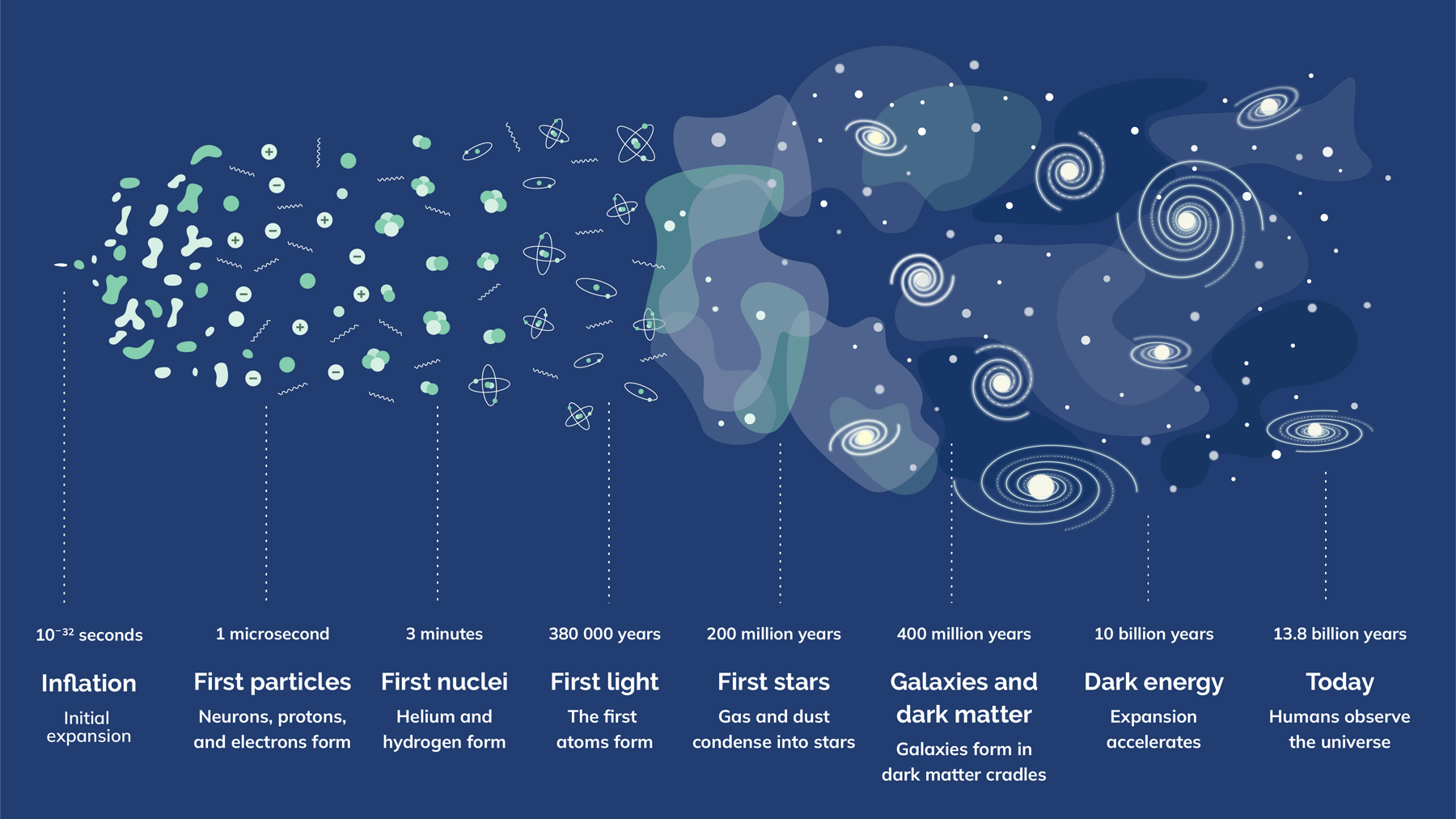
The history of the universe | Illustration by Ronel van Heerden (original diagram by Nasa)
Prof Yin-Zhe Ma: A life devoted to dark energy
Physics perfectly suits his introverted nature, admits Prof Yin-Zhe Ma, lead of the Astronomy and Astrophysics Research Group in the Department of Physics at SU. The subject has enthralled him since his teenage years, when he regularly visited his local library in search of university-level textbooks to study over weekends.
As such, it was only natural for him to continue studying physics after school. In 2006, he was ranked among the top 3% of students in the competitive, well-respected physics programmes of Nanjing University in China.
As a second-year student, Ma attended a public lecture presented by a renowned Chinese expert, Prof Tan Lu. Ever since, he has been intrigued by dark matter, dark energy, the evolution of the universe, and neutrinos.
“It was fascinating. I simply knew that this field was indeed for me. It truly set the rest of my career,” he remembers the impact of that one lecture.
“People often say that, over time, you leave the subject of your undergraduate studies behind to start working on unrelated matters. That might be true for many people, but not for me. What I learnt from my undergraduate studies is still very useful, and has provided a strong basis for my career.”
After completing an MS degree in theoretical physics through the Chinese Academy of Sciences in 2008, Ma left for the United Kingdom to pursue a PhD in astronomy at Cambridge University. Among the highlights of his stay there was meeting renowned physicist Stephen Hawking, and being personally congratulated by Lord Martin Rees, the Astronomer Royal at the time, when he received his doctorate in 2011.
Ma also spent time at the University of British Columbia in Canada and at the Jodrell Bank Centre for Astrophysics at the University of Manchester in England before being appointed as a senior lecturer at the University of KwaZulu-Natal in South Africa in 2015. While there, he was promoted to associate professor in 2018 and full professor in 2021. In 2023, he moved to SU to become the founding head of the Astrophysics Division in the Department of Physics.
This respected researcher has an h-index of 47 (40 being considered outstanding) and has published 130 refereed papers to date, 68 of them as leading author.
Since 2018, Ma has been involved in planning the Hydrogen Epoch of Reionisation Array (HERA) in South Africa. Because of his fundamental contribution to this project, he was elected as a HERA ‘Builder’ in 2021.
This SA-USA collaborative experiment targets precision measurements of the 21-cm hydrogen line in the formation of the first stars during the Cosmic Dawn and the subsequent Epoch of Reionisation, when the intergalactic medium was ionised.
Earlier in 2024, in the Publications of the Astronomical Society of the Pacific, Ma co-authored a paper detailing the deployment and commissioning of the second phase of HERA. This array is being built on the same site as MeerKAT, as a designated Square Kilometre Array pathfinder instrument.
Ma’s research on the origin and evolution of large-scale structures in the universe is continuing intensively. Some of his latest scientific contributions are contained in papers he co-authored (along with colleagues from China, Spain, and South Africa) in The Astrophysics Journal and in Astronomy and Astrophysics (along with fellow physicists from Germany, Chile, Italy, and the USA).
Ma was also the lead author of a recent paper on the study of cosmic voids, published in the Monthly Notices of the Royal Astronomical Society (MNRAS). Cosmic voids, known as the largest under-dense regions of the universe and for filling most of its volume, contain abundant cosmological information for probing dark energy, cosmic structure growth, and galaxy formation, Ma and his co-authors note.
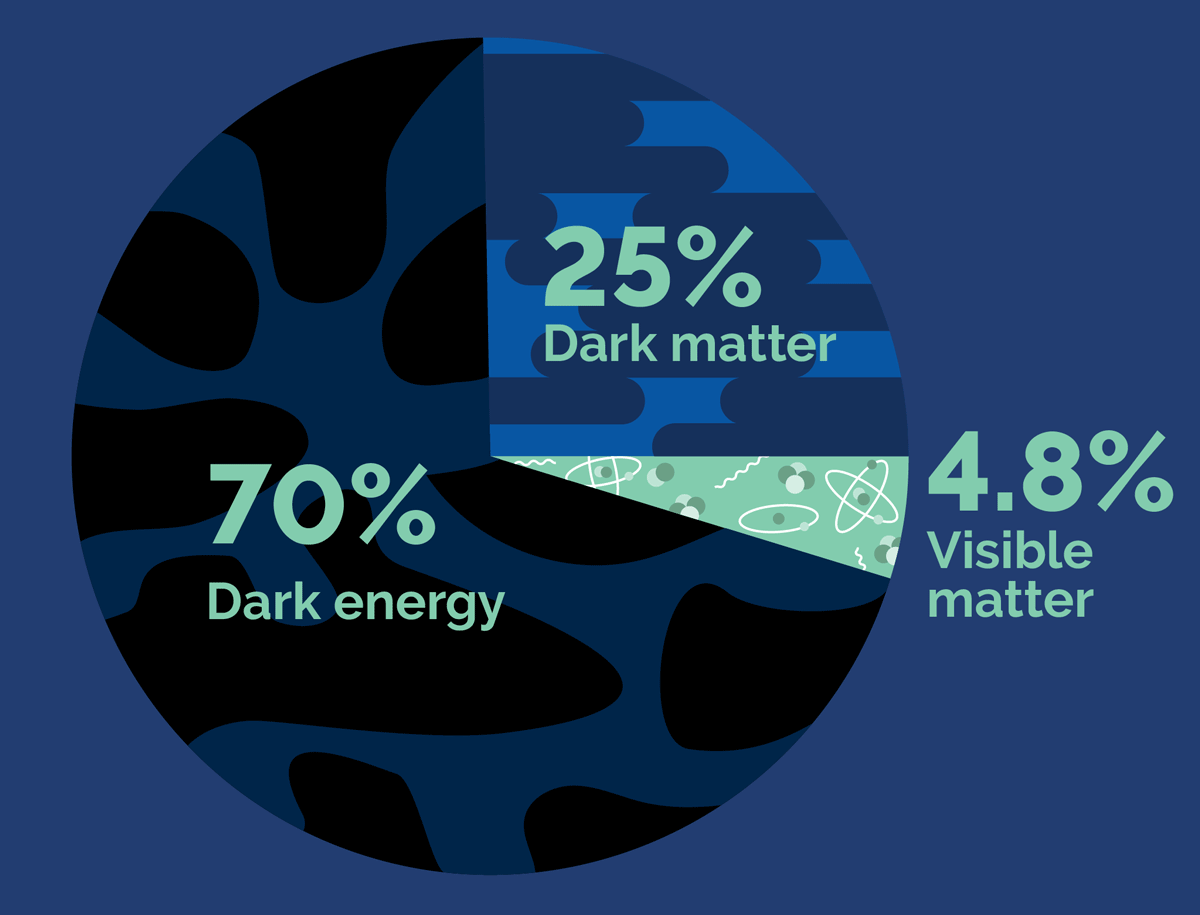
Searching for what can’t be seen
Less than 5% of the universe is visible. What is the rest made up of?
The visible universe — including Earth, the sun, other stars, and galaxies — is made of protons, neutrons, and electrons bundled together into atoms. While this ordinary (or ‘baryonic’) matter is everywhere in our daily lives, it constitutes only 4.8% of the entire universe.
The rest appears to be composed of a mysterious, invisible substance called ‘dark matter’ (25%) and a force that repels gravity, known as ‘dark energy’ (70%).
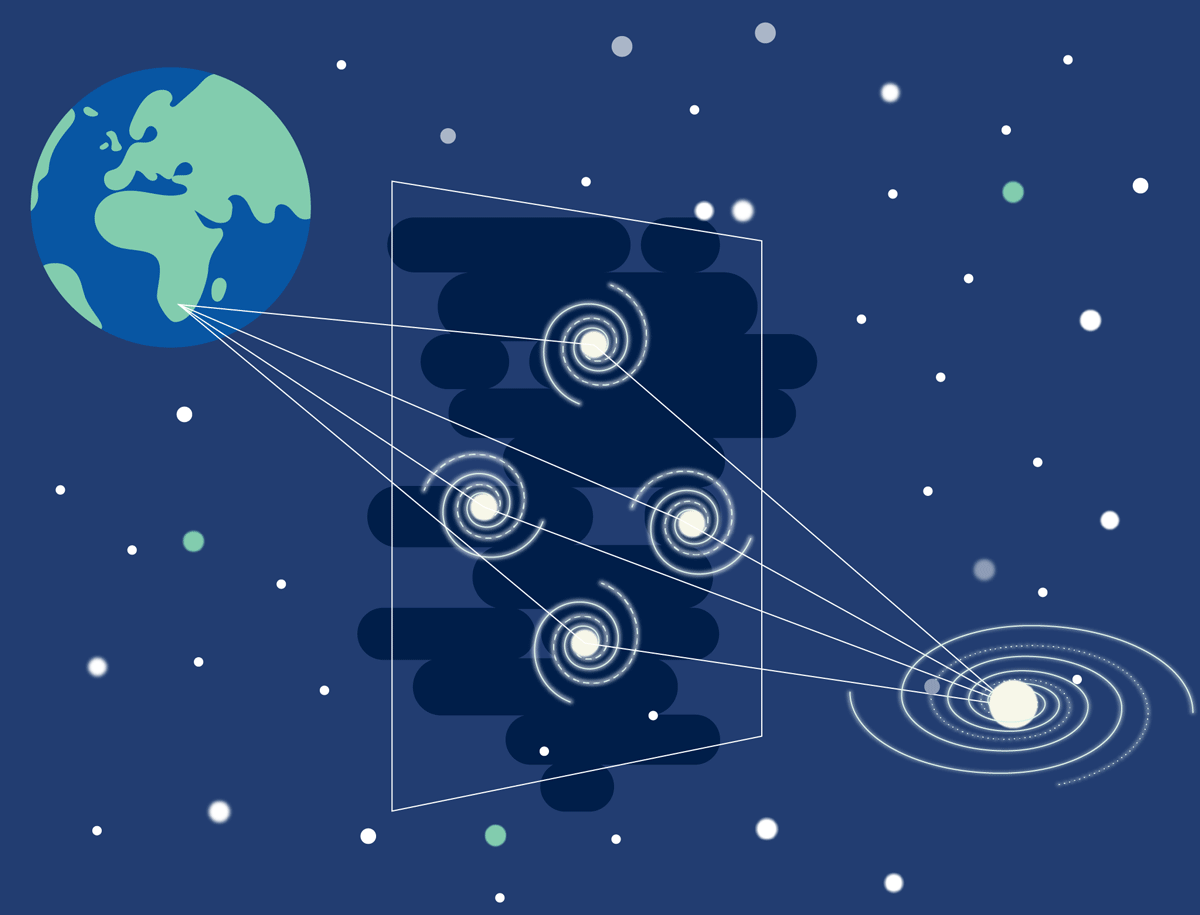
Finding the dark in space
Scientists have yet to observe dark matter directly. It doesn’t interact with baryonic matter and is entirely invisible to light and other electromagnetic radiation, making dark matter impossible to detect with current instruments. However, scientists are confident it exists because of the gravitational effects it appears to have on galaxies and galaxy clusters.
Scientists theorise that dark matter may consist of exotic particles that don’t interact with normal matter or light but still exert a gravitational pull. Some scientists also suggest that the effects of dark matter could be explained by fundamentally modifying our theories of gravity, proposing the existence of multiple forms of gravity.
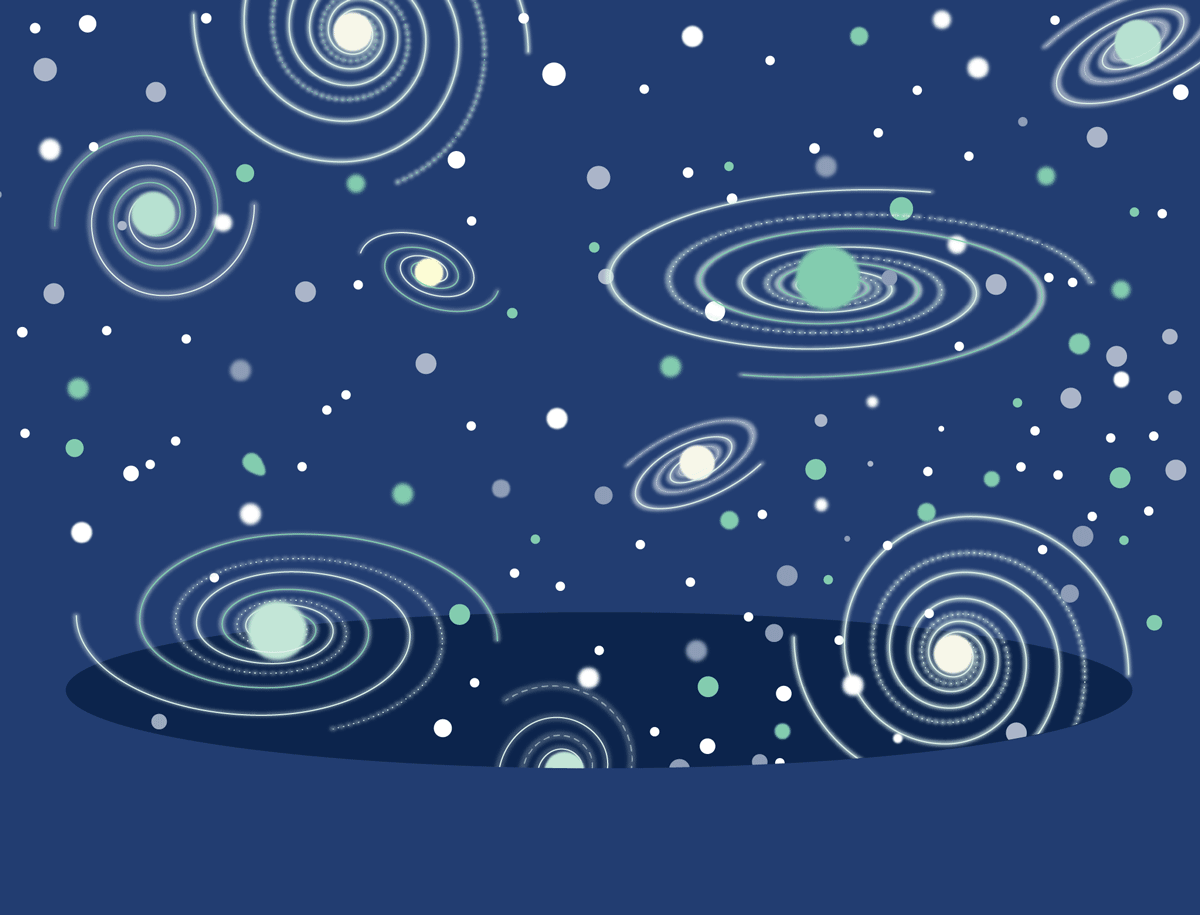
Expanding universe
Dark energy is even more mysterious, and its discovery in the 1990s shocked scientists. Physicists previously assumed gravity would slow the universe’s expansion, but measurements showed the opposite. This finding was likened to throwing a set of keys up into the air and expecting them to fall back down, only to see them fly straight up toward the ceiling.
Scientists now believe that the universe’s accelerated expansion is caused by a repelling force created by tiny energy changes in “empty” space. This force appears to become stronger as the universe gets bigger. Scientists have named this mysterious force dark energy.
The nature of dark energy lacks a viable explanation, unlike dark matter. One theory posits that dark energy could be a previously undiscovered fifth fundamental force known as quintessence, which fills the universe like a fluid.

Universe’s ‘gravitational scaffold’
The nature of dark matter remains a mystery to scientists. Even though it occupies about 27% of the universe, it does not interact with light, making it difficult to detect.
Scientists theorise that dark matter exists in a vast, web-like structure that winds through the universe – a gravitational scaffold that attracts most of the cosmos’ normal matter. Research efforts to uncover the identity of dark matter are ongoing.
Sources: NASA and National Geographic

The research initiatives reported on above are geared towards addressing the United Nations’ Sustainable Development Goals number 9 and goal number 2 of the African Union’s Agenda 2063.
Useful links
SU’s Astronomy and Astrophysics Research Group
Prof Yin-Zhe Ma’s inaugural lecture
Using the MeerKAT telescope to search for axion dark matter
CGTN interviews Prof Yin-Zhe Ma (UKZN) at the Nobel Symposium Outreach Talk
What is dark energy? Inside our accelerating, expanding universe
Map shows Earth’s position within the vast universe
X (formerly Twitter): @NITheCS, @MatiesResearch and @StellenboschUni